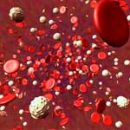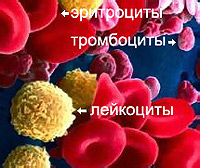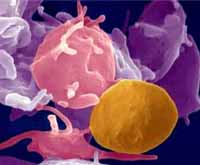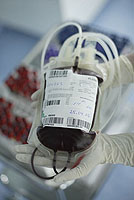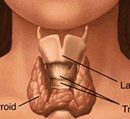Neutrophils are such small blood cells, and such useful. After all, they fall to protect our body when different infections get into it. But when these desired cells become little - neutropenia develops, and «protection» our body gives failure.
Content
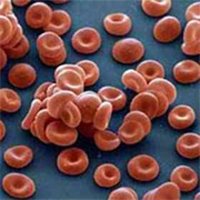 Neutropenia - Reducing the number of blood neutrophils. Neutrophils - Home Cellular System Protection of the body from bacteria and mushrooms. They play an important role in healing wounds and in the struggle of the body with alien objects.
Neutropenia - Reducing the number of blood neutrophils. Neutrophils - Home Cellular System Protection of the body from bacteria and mushrooms. They play an important role in healing wounds and in the struggle of the body with alien objects.Neutrophils ripen in bone marrow for about 2 weeks. After admission to the bloodstream, they are circulated about 6 hours in search of infectious agents and alien substances. Finding yourself «Sacrifice», Neutrophils migrate in tissue, attach to these alien agents and produce toxic substances that kill and digest them. The process is accompanied by an inflammatory response in an infected area, which is manifested by redness of the skin with the inflammation, swelling and local temperature increase.
Neutrophils Normally make up 48-78% of all leukocytes, therefore a decrease in the total number of leukocytes means a decrease in neutrophil content. When the number of neutrophils falls below 1 x 109 in 1 liter of blood (less than 25% of the total number of leukocytes), the risk of infections increases slightly, and if the number of neutrophils does not exceed 0.5 x 109 per 1 liter, this risk increases very significantly. Without protection, which neutrophils provide, a person may die of infection.
Neutropenia, along with a shortage of other types of blood cells, is characteristic of aplastic anemia. A decrease in the number of leukocytes is accompanied by some rare hereditary diseases, such as infantile genetic agranulocytosis and family neutropenia.
With cyclic hereditary neutropenia, rare disease, the number of neutrophils ranges between normal and low with a period of 21-28 days; it can fall almost to zero and then after 3-4 days spontaneously return to the norm. The probability of developing infectious diseases in patients with cyclic hereditary neutropenia increases in that period of time when the number of neutrophils is low.
Neutropenia develops in some patients with malignant tumors, tuberculosis, myelofibrosis, vitamin B12 deficiency and folic acid. Some medicines, especially used in the treatment of malignant tumors (chemotherapy), violate the ability of bone marrow to produce neutrophils. Neutrophils are destroyed faster than, with some bacterial infections, allergic diseases, autoimmune diseases and reception of a number of drugs. With an increase in the spleen (for example, with felt syndrome, malaria or sarcoidosis), the number of neutrophils may decline due to the fact that the enlarged spleen captures and destroys them.
Then establish the cause of neutrophenia. The doctor may appoint bone marrow biopsy. This procedure is unpleasant, but it is not dangerous. The sample of bone marrow is investigated under the microscope to estimate its structure, the number of neutrophil precursor cells and the production of leukocytes. Having determined the number of predecessor cells, the doctor may assume what time it is necessary in order for the content of neutrophils to normal. If the number of predecessor cells is reduced, then new neutrophils will not appear in the bloodstream for 2 weeks or more; If their number of sufficient and cells ripen normally, new neutrophils may appear in the bloodstream for several days. Sometimes the bone marrow research indicates a different disease, such as leukemia or other malignant process in blood cells.
With severe neutropenia (less than 0.5 x 109 in 1 liter of blood), various infections are rapidly developing in the patient, since there are no funds in the body to deal with pathogeful microorganisms. In such cases, patients hospitalize and immediately prescribe strong antibiotics, even before the cause and accurate localization of the infection. Increased body temperature - symptom indicating an infectious inflammatory process - in the presence of neutropenia is a signal to the provision of immediate medical care.
Sometimes there are effective growth factors that stimulate the production of leukocytes, especially the colony-posing factor of granulocytes (C-SZR) and a colonistimulating factor of granulocyte-macrophages (OM-SZR). Such treatment can prevent reduction in neutrophil content at periodic hereditary neutropenia. If neutropenia is caused by an allergic or autoimmune reaction, the corticosteroids (hormonal drugs) help (hormonal drugs). Anti-cytime globulin or some other drugs to suppress the activity of the immune system can be used in suspected an autoimmune disease, such as aplastic anemia. If the spleen is increased, its removal can contribute to increasing the number of neutrophils.
If immunosuppressants do not give effect, patients with aplastic anemia is needed transplantation (transplantation) of bone marrow. This operation may have significant side effects, requires long-term hospitalization and is carried out on strict medical testimony. For the treatment of isolated neutropenia, bone marrow transplant is very rare.

